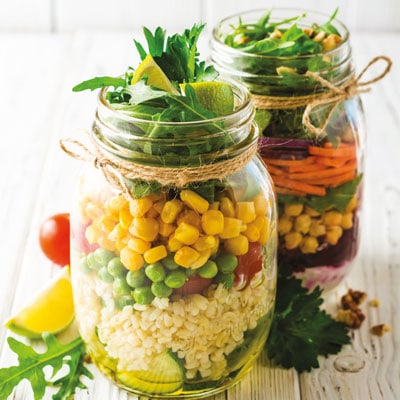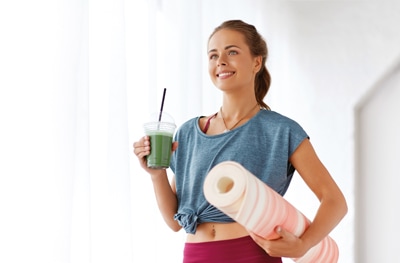
Convert your yoga recipe into a retail product
Healthy food is in demand and, with many yoga teachers a whizz in the kitchen and looking to boost earnings, maybe there’s an opportunity out there for you. Here’s what you need to know. By Richard Horwell
There are folk who will look at a tin of chickpeas and see nothing more than proto hummus, and there are people who can take the contents of that same can and briefly splash incredible flavours across the roof of your mouth like a cheffy Michelangelo. Of course, there are many fantastic recipes that don’t involve tinned legumes, and some of them have the potential to become household favourites. If you have such a recipe and you’re thinking of sharing it with the world (for money, obvs), be prepared for a long journey. It takes time to travel from kitchen stove to supermarket shelf.
Start by looking online and visiting target stores. What’s the competition? How is it selling? How do they approach their messaging? Knowledge is strength and the more knowledge you have the stronger your chances of breaking into the market and making your idea fly. After that there are a number of important steps to take:
1. Think big, be professional
It is so important to understand before you take on any business venture that the production of your product cannot be just a few cakes or drinks here and there; it’s either all or nothing. You need an experienced manufacturer (co-packer) that will make and fill the product for you. A co-packer will be looking at volume and unless you can give them confidence this project will grow (and fast), then very few will consider taking it on. They also need to believe in your product as much as you do, so before you speak to them make sure your company and brand look professional; many co-packers won’t even respond to Hotmail or Gmail addresses, so get brand ready.

2. Your ingredients
Your product could be the most delicious product in the world, sell amazingly with your friends, family and local farmer’s market, but the hardest pill to swallow is that the recipe may simply not taste the same when produced on a massive scale.
Your recipe at home has the option to be filled with the most expensive good quality fresh ingredients which provide the best end result, but if you want to mass produce then you may have to change ingredients to ensure the product isn’t ridiculously expensive and can be mass produced cost effectively. The most important thing to consider is that your ingredients need to have a longer shelf life to cope with the route to market, whether this is via wholesalers and physical retailers or mail order. New products can spend far longer sitting on the shelf than established brands so ensure you have that shelf life.
You also need to look out for allergens such as peanuts as many co-packers will refuse to fill your product due to the process of informing every client of the potential exposure. But more importantly you also need to make all allergens VERY clear to consumers. Check out the top 14 allergens (www.food.gov.uk/safety-hygiene/food-allergy-and-intolerance), and wherever possible remove them. If not, ensure you find a co-packer that can cope with the allergens, and that your packaging makes them clear.
Novel Foods is another one to look out for; beware of ingredients that may be legal in other countries but not necessarily in the UK. For this, check the Novel Foods website: www.food.gov.uk/business-guidance/regulated-products/novel-foods-guidance.
3. Shelf life
Consider the shelf life of your product. Remember new brands move slowly, no matter how good they are. So, you need to factor this in.
While really long shelf-life products are not viewed as healthy, so are less popular at the moment, it is important to remember that, generally, the longer the shelf life the better. Often, the only other way to retain the shelf life is to put preservatives in your product, however, many wholesalers and retailers refuse to accept this as part of their range. So, avoid this, if at all possible.
So, when developing your recipe, you must take into consideration whether your product can be stored for a long period of time, preferably at ambient temperatures, or if necessary, chilled. You then need to adapt your recipe to ensure it will taste just as good at the end of its shelf life as it did at the beginning. Food wastage is a big issue, environmentally and financially.
4. Get the look right
Getting your product’s packaging right is of primary importance and it’s a process many new start-ups overlook. Your packaging needs to be adaptable: what worked at a farmers’ market won’t necessarily work in a major retail outlet. The packaging needs to be sturdy and protect the product, whether it is stacked on pallets, manhandled by the wholesalers, shelf-stackers, or mail order fulfilment companies, and delivered by couriers or postal workers. It must remain in pristine condition, preferably with a minimal amount of plastic included in the packaging.
It is important to understand the best materials to pack your product in. Plastic is lightweight and durable, but currently very unpopular due to environmental reasons. Glass is more sustainable, however many wholesale buyers will not consider it due to its weight and chance of breaking in transit. So, you need packaging appropriate to the product, sturdy and protective, minimal environmental impact, easily recycled and preferably not too heavy. It’s a lot to ask.
5. Selling your product
Communicating with your target consumer is essential if you are to sell your product. However, different platforms need different approaches. What worked at the farmers’ market will not work in-store. And often what works in-store won’t also work online. So, you need to create messaging that suits the audience and the platform.
You need to make your target consumer understand what you are about and why you are preferable to the competition. Today, consumers don’t just switch for price; they want to understand the benefits of your brand and they want that information and understanding FAST. Think about why your consumers would pick up your brand and then try to communicate that on the packaging.
6. Safety first Remember that even once all the steps above have been completed, you’ll still need to get safety certification, such as HACCP (Hazard Analysis and Critical Control Point) or SALSA (Safe and Local Supplier Approved) before anyone will even entertain stocking your product. So, this must be factored into each step as well. As this will lie with the manufacturer, make certain they have these relevant certifications or are BRC (British Retail Consortium) certified.
In summary: Going from a hobby to a genuine business is a huge step for any new start up. But with the right recipe and proper planning, futures can be extraordinarily tasty.
Richard Horwell is the owner of Brand Relations (brandrelations.co.uk), a specialist food and drink marketing and branding company based in London





